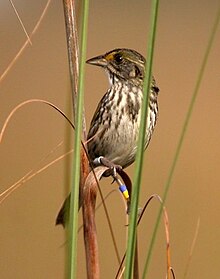Ammodramus maritimus mirabilis
| Cape Sable seaside sparrow | |
|---|---|
 |
|
| In Everglades National Park | |
| Scientific classification | |
| Kingdom: | Animalia |
| Phylum: | Chordata |
| Class: | Aves |
| Order: | Passeriformes |
| Family: | Emberizidae |
| Genus: | Ammodramus |
| Species: | A. maritimus |
| Subspecies: | A. m. mirabilis |
| Trinomial name | |
|
Ammodramus maritimus mirabilis (Howell, 1919) |
|
The Cape Sable seaside sparrow (Ammodramus maritimus mirabilis) is a subspecies of the seaside sparrow, a species of bird in the family Emberizidae native to the United States. This subspecies is endemic to southern Florida. It is designated endangered under the Endangered Species Act.
The Cape Sable seaside sparrow is 13 to 14 centimeters in length. The back is dark olive-gray and the tail and wings are olive-brown. Adults are light gray on the belly to almost white with dark olive-gray streaks on the breast and sides.
This spubspecies occurs in prairie habitat, breeding in mixed marl prairie dominated by gulf hairawn muhly (Muhlenbergia filipes). The sparrow makes cup-shaped nests attached to vegetation a few inches above the ground. A female may produce two clutches per season, and a third if conditions are favorable.
Males are very territorial, claiming a patch of prime breeding habitat and defending it. Most vocalizations are produced by the males, which perch and call loudly to defend territory and advertise to females.
Courtship behavior includes males chasing females and offering them food and nesting materials. Females may initiate the process by approaching males and begging. Male and female raise their clutch of young together, and may remain together for the next clutch.
This subspecies is omnivorous, gleaning plant and animal items from the ground, including seeds, insects, and marine invertebrates.
The Cape Sable seaside sparrow lives on the prairies of the Everglades. The largest populations are in Big Cypress National Preserve and Taylor Slough in Everglades National Park. The common name of the bird refers to Cape Sable, the southernmost point of mainland Florida and part of the Everglades.
This bird requires aquatic prairie with low water levels and open areas. Sea level rise, alterations in water flow caused by water management practices in South Florida, and natural processes such as hurricanes, have caused water level changes and flooding, reducing available habitat. Fire suppression has increased the plant density and diversity in the area, reducing the open habitat required by the sparrow. These factors contributed to its decline.
...
Wikipedia

